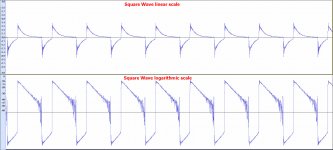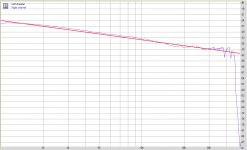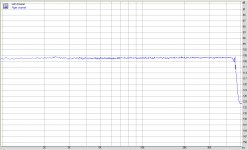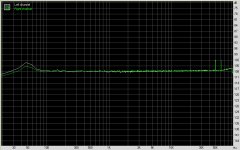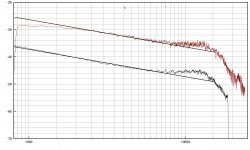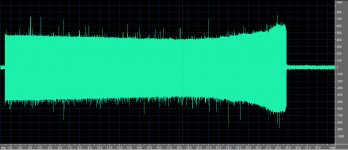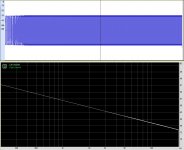No surprise then. That is meant to be played with flat eq 🙄 Otherwise looks heavily rolled off...…..
LD
But only the sweep, as indicated in instructions, is made with constant velocity.
This how a non pre-emphased 3:7 squarewave is processed by a Riaa amp.It's intentional 7:3 duty cycle 400Hz. I wonder why?
Rise times and corners look asymmetric and v soft at first sight........
LD
It looks quite different from what I have recorded.
So what could be meant ??
I'll try it anyhow with a straight amp and we'll see what it brings.
Hans
Attachments
Hope you find some clues, but I have bad feelings for this record. I never understood the sweeps or the square wave. It does not look like anything seen on my other test records.
Thinking about it, a 3:7 duty cycle for the squarewave will have dc bias. For the groove shape that presents problems I think, since one has to integrate velocity to obtain displacement, and so the offset would accumulate?
In reality, the cutter head would be ac coupled with perhaps a 20Hz high pass filter. But that's enough to tilt the tops of square waves at 400Hz...….
I don't get it.
LD
In reality, the cutter head would be ac coupled with perhaps a 20Hz high pass filter. But that's enough to tilt the tops of square waves at 400Hz...….
I don't get it.
LD
This is the same square wave but now through a flat amp.
Upper image is a linear scale, lower image on a logarithmic scale.
Sampled with 192K/24.
Looks almost like a one pole hi-pass? On a log scale it is a straight line and if extrapolated both positive and negative intersect zero in about the same time. This is an easy way to get the time constant. Still what the intent was is not obvious.
And here is the Ortofon sweep Track, played through a flat preamp, again recorded with 192K/24bit.
The Red line represents a 10dB/oct line for a perfect logarithmic CV sweep spectrum.
Deviation on average is quite good to my feeling, but a bit a bit turbulent at the end.
Compared to the Adjust+ record, this sweep is "noisier", most likely because it is much shorter in time.
I have chosen for a 1024 points FFT with 75% overlap, resulting in 1065 data points on the curve.
Hans
The Red line represents a 10dB/oct line for a perfect logarithmic CV sweep spectrum.
Deviation on average is quite good to my feeling, but a bit a bit turbulent at the end.
Compared to the Adjust+ record, this sweep is "noisier", most likely because it is much shorter in time.
I have chosen for a 1024 points FFT with 75% overlap, resulting in 1065 data points on the curve.
Hans
Attachments
And just for completeness, here is the noise with PU arm in the air through the straight amp.
Seeing the deviations and roll off between 40kHz and 50kHz, I'm not yet sure what's causing this and whether there is some filter contributing to the fact that the Ortofon FR curve doesn't go to 50kHz but only to 45kHz.
So there's still work in progress.
Hans
Seeing the deviations and roll off between 40kHz and 50kHz, I'm not yet sure what's causing this and whether there is some filter contributing to the fact that the Ortofon FR curve doesn't go to 50kHz but only to 45kHz.
So there's still work in progress.
Hans
Attachments
Just found the cause.
My signal processing card, is not listening to Audacity, and keeps working at 96kHz.
Hans
My signal processing card, is not listening to Audacity, and keeps working at 96kHz.
Hans
Think that's the artefact of removing the dc at the cutter with a high pass.........sure looks like. Why 3:7 beats me. LDLooks almost like a one pole hi-pass? On a log scale it is a straight line and if extrapolated both positive and negative intersect zero in about the same time. This is an easy way to get the time constant. Still what the intent was is not obvious.
Last edited:
Below is a comparison Elipson vs Ortofon (red curve). The Elipson is better between 800 Hz to 8 kHz. Showing 800 Hz to 25 kHz in this case.
Attachments
Last edited:
And here is the Ortofon sweep Track, played through a flat preamp, again recorded with 192K/24bit.
Hans
@Hans that was recorded flat.
O.k., so you played through a flat preamp ?
In that case it is still a logarithmic sweep going down with 10dB/dec.
Hans, why do you process the raw data in this way? If you look at JP's raw data it is nearly flat because CV cutter and cartridge are complementary i.e. a perfect cartridge would be perfectly flat when there is no RIAA, the sweep would make no difference. CV is proportional to f so it is 20db/dec not 10. The constant velocity region of the RIAA curve (past ~2k) is a single pole roll off, so 20db/dec.
Attachments
This is true. Confused yoda is. Also, where has the top resonance gone, be it mass-vinyl spring or cantilever flex, it has to be there.......?CV is proportional to f so it is 20db/dec not 10
LD
The high pass has an estimated time constant of ca 380usec or 420Hz.Think that's the artefact of removing the dc at the cutter with a high pass.........sure looks like. Why 3:7 beats me. LD
Hans
This is a perfect CV file and its FFT, without processing in between.Hans, why do you process the raw data in this way? If you look at JP's raw data it is nearly flat because CV cutter and cartridge are complementary i.e. a perfect cartridge would be perfectly flat when there is no RIAA, the sweep would make no difference. CV is proportional to f so it is 20db/dec not 10. The constant velocity region of the RIAA curve (past ~2k) is a single pole roll off, so 20db/dec.
Does it go down by 20dB/dec, I don't think so.
Hans
Attachments
For the same reason as PN goes down by 10dB/dec.Why not ?
LD
a logarithmic sweep has equal energy per octave or per decade, so with an FFT with constant filter bin width, the energy per bin goes down with 3dB/oct or 10dB/dec.
Hans
- Status
- Not open for further replies.
- Home
- Source & Line
- Analogue Source
- Cartridge dynamic behaviour

